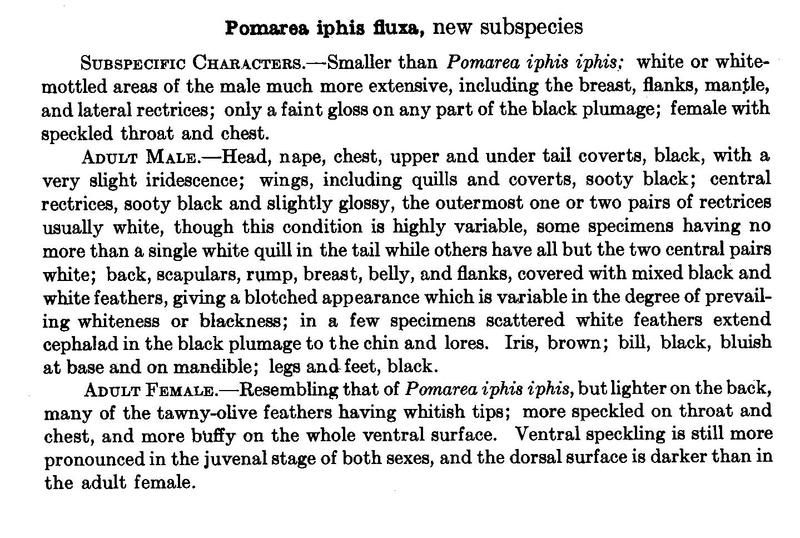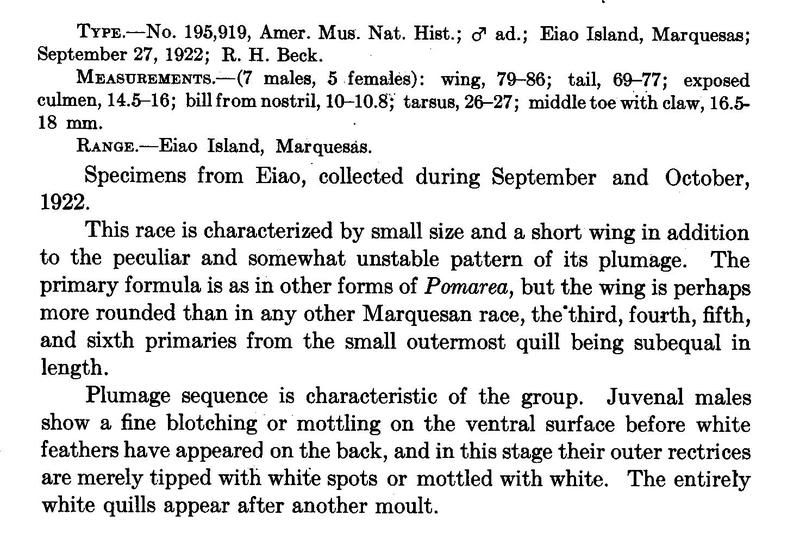Post by sebbe67 on Apr 24, 2005 12:34:19 GMT
Eiao Monarch Pomarea fluxa (Murphy & Matthews, 1928)
Status: It was last collected in October 1922. Last recorded on 7 August 1977 (Montgomery et al., 1980). It is now considered to be extinct (Thibault, 1989; Thibault & Meyer, 2001; Cibois et al. 2004; del Hoyo et al., 2016; Thibault & Cibois, 2017).
Museum specimens: New York (AMNH).
Taxonomy: Monotypic Species. It was originally described as a subspecies of the Ua Huka Monarch P. iphis (Murphy & Matthews, 1928), but it has since been given full species status (Cibois et al., 2004).
Distribution: Endemic to Eiao, Marquesas islands, French Polynesia.
Natural History
Inhabited low-elevation dry forests, mainly composed of Pisonia grandis and Thespesia populnea. It foraged for insect prey in the dense underbrush (Decker, 1973; Thibault, 1992; Butaud & Jacq, 2007; Thibault & Cibois, 2017).
Conservation Status
It was discovered on this uninhabited island on 20 September 1922 by members of the Whitney South Sea Expedition (WSSE) who collected at least 55 specimens in September-October (Murphy & Matthews, 1928; Holyoak & Thibault, 1984). Beck (1920-1924) wrote that it was "common" in groves in the lowest part of the island, but absent from the bushes on the inland plateau. Fisher was unable to find it during a brief stop in 1929 (Fisher & Wetmore, 1931) nor did Jean-Claude Thibault on 29 September 1975 (Thibault & Cibois, 2017). But on 7 August 1977 "a few Marquesan Flycatchers (P. mendozae) were seen" by experianced naturalists (Montgomery et al., 1980). Ten years later, however, all searches by Jean-Claude Thibault from 12 July to 8 August remained unsuccesful. The area searched represented most of the wooded land from sea-level to the inland plateau, and in the Opituha Canyon on the western side (Thibault, 1989). Several visits conducted in the 2000s were also unsuccessful in finding this species (Butaud & Jacq, 2007; Thibault & Cibois, 2017).
The native low-elevation forests of Eiao has drastically decreased due to over-grazing by feral sheep introdcued ca. 1880 ((Holyoak & Thibault, 1984; Thibault & Meyer, 2001). But this alone cannot explain why this species became extinct, because the overall area of the forest is higher than that of Mohotani where P. mendozae is still present today (Butaud & Jacq, 2013; Thibault & Cibois, 2017).
Its main cause of extinction is more likely the introduction of Black Rats R. rattus which may have occured in the 1970s when the island was occupied to test the suitability of its deep geological bed for atomic bomb tests (Thibault & Cibois, 2017). The construction of a small village on the plateau and a wharf at Avaneo necessiated a lot of materials being brought to the island, and no quarantine measures were conducted at that time (Thibault & Cibois, 2017). Introduced feral cats and Polynesian rats were also present at the time of the species's demise and may have contributed to declines. The introduction of Chestnut-breasted Munia Lonchura castaneothorax coincided with its extinction on the island, implying that an avian disease may have been transmitted to this population (Thibault, 1989).
- References -
- Cibois, A., Thibault, J.C. & Pasquet, E. 2004. Biogeography of Eastern Polynesian Monarchs (Pomarea): an endemic genus close to extinction. Condor 106: 837-851.
- del Hoyo, J., Collar, N.J., Christie, D.A., Elliott, A., Fishpool, L.D.C., Boesman, P. and Kirwan, G.M. 2016. HBW and BirdLife International Illustrated Checklist of the Birds of the World. Volume 2: Passerines. Lynx Edicions and BirdLife International, Barcelona, Spain and Cambridge, UK.
- Fisher, A. K. & Wetmore, A. 1931. Report on birds recorded by the Pinchot Expedition of 1929 to the Caribbean and the Pacific. Proceedings of the United States Natural History Museum 79: 1-66.
- Holyoak, D. T. & Thibault, J.C. 1984. Contribution à l'étude des oiseaux de Polynésie orientale. Memoires du Museum National d'Histoire Naturelle - Serie A: Zoologie 127: 1-209.
- Montgomery, SL., Gagné, W.C & Gagné, B.H. 1980. Notes on birdlife and nature conservation in the Marquesas and Society Islands. Elepaio 40: 152–155.
- Thibault, J.C. 1989. L'avifaune des îles Eiao et Hatuta'a (Polynésie, Pacifique Sud): modifications intervenues au XXe siècle. L'Oiseau et la Revue Française d'Ornithologie 59: 305.
- Thibault, J.C. & Meyer, J.Y. 2001. Contemporary extinction and population declines of the monarchs (Pomarea spp.) in French Polynesia, South Pacific. Oryx 35: 73-80.
- Thibault, J.C. & Cibois, A. 2017. Birds of Eastern Polynesia. A Biogeographic Atlas. Lynx Edicions, Barcelona.






